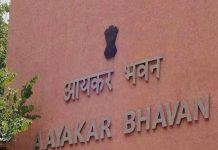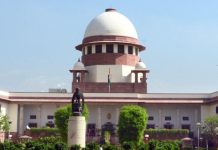
For millions of tourists, not to speak of pilgrims, who visit Guwahati in northeast India, Kamrup remains synonymous to Goddess Kamakhya or Kameshwari (Goddess of Desire). And, most of them pay a sacred visit to the pre-historic Kamakhya temple nestled atop Nilachal hills in the heart of the city on the southern bank of the mighty Brahmaputra. Now, a small district covering the city of Guwahati with its fringe areas, Kamrup was otherwise a gigantic empire covering all eastern Indian provinces in the days of Mahabharat.
One of the major religious festivals organised annually in the picturesque temple is the Ambubachi Mela (also known as Amoti and Ambabati) that attracts hundred thousand Hindu pilgrims from various parts of the globe. So like previous occasions, this year’s Ambubachi festival (22 June to 25 June 2018) also emerges as a major challenge for the administration and a rare opportunity for the Guwahatians to showcase their hospitability to the visitors.
During the revered festival, the temple’s primary door gets closed for the first three days. The religious belief narrates that during the period the Mother Earth experiences the annual cycle of menstruation and it is reflected in Devi Kamakhya’s genital organ (Yoni). No religious performances are organised in this period. The farmers across the Hindu world avoid cultivating works during the period so that Mother Earth can get an undisturbed ambience.
On the fourth day, the temple door is reopened after Devi’s ritual-bathing and devotees throng in for Darshan and worshipping Maa Kamakhya. Devotees expect a small piece of Rakta Bastra (red silk cloth, which Devi uses during the period) and regard the Anga Bastra as very precious. One can witness a sea of humans with a large number of Hindu saints in the temple premises during the festival.
Kamakhya temple, which is recognised as one of sacred 108 Shakti Peeths of Mother Goddess Durga was built by Kamdev (God of Lust) with the help of God Vishwakarma. According to the Hindu mythology, the demon king Narakasura constructed a stiffstone path (known as Mekhela Ujowa Poth) connecting the temple from the foothills with an aim to marry Devi Kamakhya.
The Muslim convert Kalapahar, the king of Coach Behar in western Assam destroyed the temple in 1553 AD. Maharaja Biswa Singh later repaired it in the seventeenth century. The king Nar Narayan, who ascended to the throne of Coach Behar after his father Biswa Singh’s demise, constructed the upper portion of the temple with the help of his brother Mahabir Chilarai. The present form of the main temple and its surrounding was shaped during the time of Nar Narayan, one of the greatest kings of ancient Assam.
As the legend goes, Sati (Kamakhya or Parvati) was one of the incarnations of Goddess Shakti and she sacrificed her life protesting the behaviour of her father Dakshya Nripati. The wife of Maheswar (one of the holy Hindu Trinities after Lord Brahma and Lord Bishnu), Sati took her life at a Yagna, a sacrificial rite organized by her father Dakshya. The son of Brahma, Dakshya was not happy with his son-in-law (Shiva or Mahadev or Maheswar, the destroyer of the universe). Shiva was even not invited for the ceremony.
Sati arrived at Yagna Bhumi, but she was also not welcomed by Dakshya. He also made some unpleasant comments on Shiva. Annoyed Sati sacrificed her life at the location of Yagna. Listening to the death of Sati, Shiva got angry and appeared at Yagna Bhumi. After pronouncing punishment to Dakshya, furious Shiva started Tandav Nritya (the dance of demolition) with the corpse of his beloved wife Sati on his shoulder. The Tandav Nritya continued for several days and the universe was on the brink of being destroyed.
Apprehending it, all the gods and goddesses appealed Lord Bishnu to pave way for bringing an end to Maheshwar’s dance of destruction. The caretaker of the universe chopped-off the corpse of Sati with his Sudarshan Chakra to bring back Shiva to sanity. Her lifeless body was made into 51 pieces, which fell in different parts of Bharatbarsha and each location later emerged as a holy place (Shakti Peeth). The Yoni of Sati fell on the spot at Nilachal hills, where the Kamakhya temple was erected.
Many other legends relating to Devi Bhagawati still spread in the society. In such a legend, it is said that once Devi appeared before Narakasur, the demon king of Pragjyotispur. The powerful king got attracted to the unusual beauty of Devi Kamakhya and fell in love with the deity. Even the proud king proposed to marry her. Devi put a condition to the king that she might agree to his proposal if the king can construct a stone path from the foothills to the temple in a single night.
Confident Narakasura agreed to the condition and he started the work at dusk. The demon king had almost completed the stone path.
Witnessing the rapid work, worried Kamakhya ordered an elusive-cock to start crowing that symbolizes the dawn. Smelling conspiracy, the king chased the cock and finally killed it. Later, the Devi killed Narakasura with the help of Lord Bishnu.
Kalika Purana, an ancient work in Sanskrit describes Devi Kamakhya as the deity to fulfil the desires of devotees and gives salvation. The temple does not contain any image or statue of Kamakhya. There is only a sculptured image of the Yoni of the Goddess in a cave inside the main temple. A natural spring believes to keep the stone always moist.
The devotees with all purity touch the silk cloth draped stone and offer Bilwa Patra and flowers on it. Besides Ambubachi, many other religious festivals are organized in the sacrosanct temple premises annually that include Durga Puja, Basanti Puja, Manasa Puja, Shivaratri Mahotsav etc. Visitors (read Hindus) are allowed to have Darshan and worship Maa Kamakhya in the daytime.
Though there is no visible notice or announcement that the temple is open only for Hindus, the Pandas (assistants to priests) keep preaching about it. The temple has over 150 recognised priests, whereas more than 500 Pandas stay on the campus to help the devotees in various rituals. A pond nearby the main temple named Soubhagya Kunda (fortune pond) is believed to be built by Devaraj Indra. Religious rites are performed in western bank of the pond. Devotees believe that going round the pond is a holy exercise. There is another pond named Bhairab Kunda in the temple premises, which is famous for few giant turtles.
Sacrifices are done every morning in the temple before the Puja starts. The sacrifice by the devotees can be of anything like pigeon, goat, buffalo ,etc. However, nowadays they prefer to set free the animals taken for sacrifices. The large flocks of pigeons, eve the goats, in the temple campus have grown up together.
Marriages with Hindu rituals are also arranged in the temple regularly with necessary precautions.
The author is a Guwahati based political commentator
letters@tehelka.com













